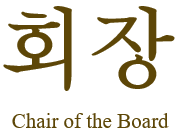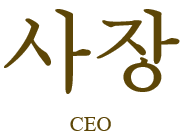Korean Corporate Titles
In this article, we will show you some of the widely used Korean corporate titles (job titles) and translate them to English. At the bottom of this article, you will also find job titles translated in the reverse direction (from English to Korean).
In a business setting in Korea, people address each other on a last-name basis, and a job title always follows a person’s last name. This is true even for co-workers in the same office and regardless of whether the communication is face-to-face or in writing.
If you are not familiar with the Korean language, personal names combined with job titles may sound confusing. For example, a Korean sentence in an e-mail message may read (when translated):
"Shim Moo Jin Sang Moo will be waiting for Jung Jin Woo Jun Moo at the airport."
This translation is impossible to comprehend, of course. Now, we will write it in a slightly different way. To help English speakers, the syllables in a given name will be linked with a hyphen (although hyphens are not always used when Koreans write their names in English); surnames will be written in capital letters and moved to the last position of the name (as in English); and the job titles will be put into brackets.
"Moo-Jin SHIM (Sang Moo) will be waiting for Jin-Woo JUNG (Jun Moo) at the airport."
Written this way, it's a bit more digestible. But, what do the job titles, “Sang Moo” and “Jun Moo”, mean?
Korean Corporate Titles Translated into English
The table below shows Korean executive titles, some of which you may have seen in the business cards or e-mail signatures of your Korean business partners. Due to the differences in the laws and corporate cultures between Korea and English-speaking countries, these titles may not have direct English counterparts.
Important Note: When you address someone directly with his/her job title, you should always add one additional syllable, “-Nim” (님), at the end to be polite. For example, when you talk to someone who is CEO of a company, never address him/her as “Sah Jang” — always say “Sah Jang Nim” (the last syllable “Nim” indicates that you are using the job title with respect). Using any of the job titles shown on this page without adding “Nim” in the presence of the person holding the title is extremely, unacceptably rude in Korea. On the other hand, the extra syllable, “-Nim”, should be omitted when the title is used from an objective point of view -- for example, in a news release or in an annual report.
| Title Written in Korean | Spoken | Approximate Representation of the Sound | Literal Meaning | English Translation | Respectful Form (with "Nim") | Spoken Respectfully (with "Nim") |
|---|---|---|---|---|---|---|
| 회장 | "Hoe Jang" | Hoe (회) = Board Jang (장) = Chief | Chairman / Chairwoman of the Board | 회장님 | ||
| 부회장 | "Boo Hoe Jang" | Boo (부 ) = Vice Hoe (회) = Board Jang (장) = Chief | Vice Chairman / Vice Chairwoman of the Board | 부회장님 | ||
| 사장 | "Sah Jang" | Sah (사) = Company Jang (장) = Chief | President or CEO | 사장님 | ||
| 대표이사 | "Dae Pyo Ee Sa" | This is the individual who bears the ultimate legal responsibilities for the conduct of the company; the same individual as “Sah Jang” in most small- and medium-sized companies. Dae Pyo (대표): often translated as “representative", which, albeit literally correct, could be misleading. The Korean word means the "head" (typically the most senior member) of a group, not a "delegate", "proxy" or "company rep". Ee Sa (이사)= Director (a member of the Board of Directors) | No English equivalent; corresponds to President or CEO | 대표이사님 | ||
| 대표 | "Dae Pyo" | Abbreviated form of "Dae Pyo Ee Sa" | No English equivalent; corresponds to President or CEO | 대표님 | ||
| 부사장 | "Boo Sah Jang" | 부 (Boo) = Vice 사 (Sah) = Company 장 (Jang) = Chief | Vice President | 부사장님 | ||
| 전무 (short form of 전무이사) | "Jun Moo" (short form of "Jun Moo Ee Sa") | Jun (전) = All Moo (무) = Duty, Affairs, In Charge Ee Sa (이사)= Director (a member of the Board of Directors) Roughly, “Director in charge of all aspects of the company” | As this position has no English counterpart, it can be translated in various ways, depending on the company’s preference. For example, a company may choose to translate this position as “Executive Vice President” or some other variations. | 전무님 | ||
| 상무 (short form of 상무이사) | "Sang Moo" (short form of "Sang Moo Ee Sa") | Sang (상) = Routine, Always Moo (무) = Duty, Affairs, In Charge Ee Sa (이사)= Director (a member of the Board of Directors) Roughly, “Director in charge of routine matters of the company” | As this position has no English counterpart, it can be translated in various ways, depending on the company’s preference. For example, a company may choose to translate this position as “Managing Director” or some other variations. | 상무님 | ||
| 이사 | "Ee Sa" | Ee Sa (이사)= Director (a member of the Board of Directors) | Director | 이사님 |
Non-Executive Titles
• Respectful forms are not shown for space considerations.
• The units involved (Boo, Gwa, etc.) can be translated as “Division”, "Department", “Section” or some other variations.
| Korean Title | Spoken | Approximate Representation of the Sound | Literal Meaning of the Term | Possible English Translation |
|---|---|---|---|---|
| 부장 | "Boo Jang" | Boo (부) = Division, Department, Section Jang (장) = Chief | Department / Section Head | |
| 차장 | "Cha Jang" | Cha (차) = Vice; Deputy Jang (장) = Chief | Vice Head of a Department / Section | |
| 과장 | "Gwa Jang" | Gwa (과) = a unit smaller than a “Boo” Jang (장) = Chief | Department / Section Head | |
| 대리 | "Dae Ree" | The term “Dae Ree” literally means "deputy". When used as a stand-alone title without a qualifier, it is simply a rank, often lower than “Gwa Jang”. | (No English Equivalent) | |
| 계장 | "Gye Jang" | Gye (계) = a unit often smaller than a "Gwa" Jang (장) = Chief | Section Head / Team Leader | |
| 팀장 | "Team Jang" | 팀 (the sound of the English word "Team" written in Korean) Jang (장) = Chief | Team Leader |
English Corporate Titles Translated into Korean
C-level English job titles don't match with the concepts of the Korean job titles that appear in Korean articles of incorporation or company charters (perhaps with the exception of CEO, which is equivalent to “Dae Pyo Ee Sa” or “Sah Jang”). Today, there is a near consensus in Korea that what is shown in the second column of the table is the best way to translate the C-level English titles into Korean.
| English Title | Korean Translation | Spoken | Literal Meaning | Acceptable Alternative Translation |
|---|---|---|---|---|
| CEO | 최고경영자 | 최고 (Choe Go) = Highest, Chief 경영 (Gyung Young) = Management 자 (Ja) = Person | 사장 (Sah Jang) or 대표이사 (Dae Pyo Ee Sa) | |
| CFO | 최고재무책임자 | 최고 (Choe Go) = Highest, Chief 재무 (Jae Moo) = Financial Matters 책임자 (Chaek Im Ja) = Person Responsible | ||
| COO | 최고운영책임자 | 최고 (Choe Go) = Highest, Chief 운영 (Woon Young) = Operation 책임자 (Chaek Im Ja) = Person Responsible | ||
| CTO | 최고기술책임자 | 최고 (Choe Go) = Highest, Chief 기술 (Gi Sool) = Technology 책임자 (Chaek Im Ja) = Person Responsible |
Brought to you by Enunce, LLC, a professional Korean translation company.
We translate legal, technical and business documents from Korean to English and from English to Korean. We also offer Korean interpretation services.

